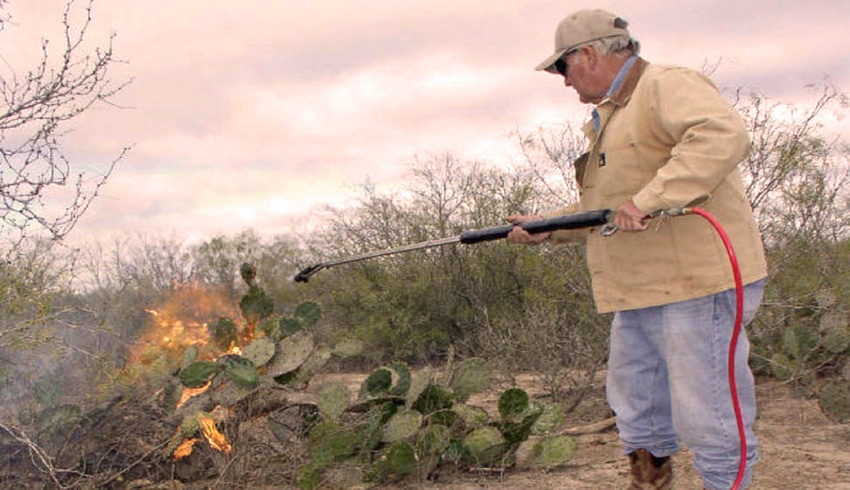March 28, 2013

The unrelenting drought is taking its toll on South Texas cattle ranchers who are resorting to a centuries-old emergency method of feeding cattle, according to a Texas A&M AgriLife Extension Service agent.
“Ranchers down here commonly refer to it as ‘chamuscando,’ the Spanish word for the process of burning off spines from prickly pear cactus so cattle can eat the pads for food and water,” said Omar Montemayor, an AgriLife Extension agent in Starr County. “For many of our aging ranchers, chamuscando (pronounced chah-moos-KAHN-doh) and hauling hay and water to their livestock are last ditch efforts to stay in the cattle business.”
Burning cactus is a practice that dates back to the mid-1700s when Spanish settlers moved here from Mexico City and raised cattle for sustenance along both sides of the Rio Grande, Montemayor said. The pioneers burned cactus over mesquite fires, which eventually gave way to kerosene burners until the 1950s when ranchers switched to butane then propane.
“In times of drought, when pastures have no grass or hay for cattle to feed on, ranchers use a propane-fueled torch to burn the needles off nopal, or cactus. The pads or stems of the plant contain moisture and fiber, but very little protein. Ranchers supplement their cattle’s diets with protein pellets called range cubes.”
Chamuscando and hauling supplemental feed, hay and water to cattle are costly measures, Montemayor said, but for many South Texas ranchers, time may be too short to sell their herds now and rebuild if and when the drought breaks.
“Many of our ranchers are in their late 60s and 70s,” he said. “If they sell their cattle and the drought ends next year, they’ll have to buy young cattle back. If a rancher pays $2,400 for a ‘pair,’ a cow and a young calf, he or she will have to wait four to five years to sell four or five calves just to recoup their investment.
“For a lot of ranchers, that’s time they think they may not have, so they’re doing everything they can to keep their cattle alive now. But it’s hard work and very expensive.”
Once cattle start eating burned cactus, a rancher has to have a plentiful supply on hand.
“When ranchers burn cactus, they have to burn at least a two-day supply because cattle used to eating cactus will eat it with spines and all if the burned cactus runs out. That results in mouth injuries, they stop eating and a rancher has a whole new set of problems.”
At an average cost of $3.50 per gallon of propane, a rancher with 30 head of cattle will spend about $35 per day just on the fuel to burn cactus, Montemayor said.
“Hopefully, a rancher has plenty of cactus on his ranch land. Then there’s the cost of the protein supplement. Some set out molasses tubs which help with the livestock’s hydration and digestive process.”
Water long gone
Thirsty cattle require lots of water, a commodity long since gone from many South Texas ranches.
“For ranchers without windmills or wells, there’s the cost of hauling water to these ranches where ponds have long ago dried up. Some ranchers have been hauling water to their ranches for two or three years. A lactating cow consumes about 20 gallons of water per day, so with 30 head, you’re talking about a lot of water daily. ”
Ranchers use all sorts of make-shift and customized tanks and trailers to haul untreated Rio Grande water from municipal water treatment plants to their ranches behind pickup trucks burning $4 per gallon diesel fuel. Cost of the water is relatively cheap, at about $10 for 500 gallons, but the trips are almost non-stop, Montemayor said.
“Once a drought starts drying up the natural resources of a ranch, expenses and efforts increase tremendously. Equipment gets more use, which means added repairs and maintenance; the list just goes on and on.”
Ranchers have also been buying hay, available nearby in the lower counties of the Rio Grande Valley where fields have been irrigated. But that won’t last long either, he said.
“A round bale of hay is going for about $100, but as water districts start cutting back on the irrigation water that hay growers have had, hay will become more scarce and more expensive.”
Montemayor said a South Texas way of life going back more than 250 years is very much at risk.
“Our ranchers are not youngsters,” he said. “The expense and effort they have to put in is taking a terrible toll. With little or no rain since Hurricane Alex in 2009, and none in the forecast, we could be looking at the end of an era here. Ranchers, like farmers, are very optimistic, but how long can they hold out?”
You May Also Like




